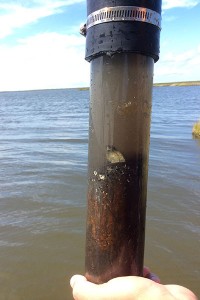Posted Dec. 8, 2015
Brady Blackburn is in his junior year at the University of North Carolina at Chapel Hill. He is majoring in environmental studies and focusing on science communication.

We used the water from cores such as this one to measure benthic chl a values. Photo by UNC Outer Banks Field Site students.
Throughout this fall semester, I have been part of a group of students from the University of North Carolina at Chapel Hill studying in Manteo, N.C. We are researching oyster aquaculture, focusing on how its environmental services compare to those of wild oyster reefs.
Our study encompasses how oysters impact water quality and submerged aquatic vegetation, the bivalves’ filtration abilities, and how the coastal community views aquaculture.
We are using the concentrations of chlorophyll a, also known as chl a, at each of our sites to assess water quality. Chl a is a pigment that plays an essential role in photosynthesis. Its concentration in a water sample can be used to estimate the amount of phytoplankton in the water.
Lindsay Dubbs, the associate director of the Outer Banks Field Site, where we are studying this semester, says that phytoplankton activity, estimated by chl a concentrations, is also a good indicator of the broader health of an ecosystem.
“Chlorophyll concentrations are basically an indicator of the basis of the food web,” she says, adding that “phytoplankton are one of the important primary producers in the estuarine ecosystem.”
There is a fine balance, however. “If you have too much chlorophyll, it might mean that you have excess nutrients in the water column that could be causing algal blooms,” Lindsay explains.
Phytoplankton are the primary food source for oysters. Because of this, we predicted that the presence of oysters would decrease their concentration in the water column, potentially preventing harmful algal blooms.
As it turned out, that wasn’t the case. We found that there was no significant difference in the chl a concentrations among any of our study sites — an aquaculture facility, a wild oyster reef and an oyster-free control site.

We have been conducting all our field work from this boat this semester. Photo by UNC Outer Banks Field Site students.
There are many possible explanations for this. Oysters and phytoplankton interact in many ways beyond the oysters’ dinner table.
“There are some algae that might, for instance, use the oysters as habitat,” Lindsay says. The algae can break off due to water flow and become planktonic algae.
Another possibility is that decreased turbidity — how clear the water is — makes it easier for the phytoplankton to photosynthesize and reproduce. Decreased turbidity is another service that oysters provide as they filter water.
Water flow plays an important role in open-system studies such as ours. The sites we studied are not closed off to outside influences. Filtered water from the oysters can easily flow out and unfiltered water can flow in, adding variability to the data we collect.
Because of this, we also conducted an in-lab filtration study to see how quickly oysters decrease turbidity and chl a in a closed system.
As the semester comes to an end, my course mates and I are compiling our final report.
The document will include our analyses of the natural science aspect of our work, that includes results from this chl a study, as well as evaluations of other water-quality parameters. It also will focus on the social science aspect, where we interviewed about 30 community members to evaluate their perceptions of oyster aquaculture and the sound as a whole.
The report will be available soon at csi.northcarolina.edu/content/education/obxfs.htm.